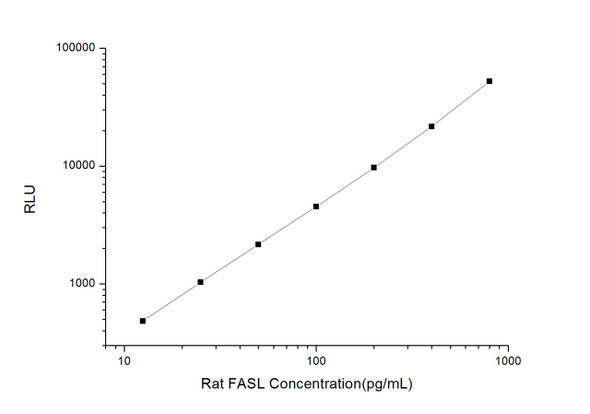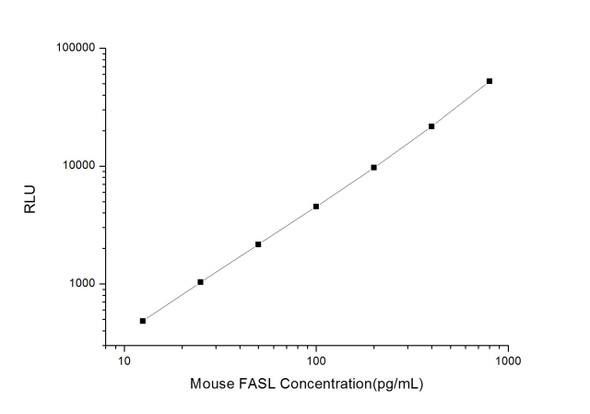Human Cell Death ELISA Kits
Human FASL/TNFSF6 (Factor Related Apoptosis Ligand) CLIA Kit (HUES00066)
- SKU:
- HUES00066
- Product Type:
- ELISA Kit
- ELISA Type:
- CLIA Kit
- Size:
- 96 Assays
- Sensitivity:
- 7.5pg/mL
- Range:
- 12.5-800pg/mL
- ELISA Type:
- Sandwich
- Synonyms:
- FASLG, ALPS1B, APT1LG1, APTL, CD178, CD95L
- Reactivity:
- Human
- Sample Type:
- Serum, plasma and other biological fluids
- Research Area:
- Cell Death
Description
| Assay type: | Sandwich |
| Format: | 96T |
| Assay time: | 4.5h |
| Reactivity: | Human |
| Detection method: | Chemiluminescence |
| Detection range: | 12.50-800 pg/mL |
| Sensitivity: | 7.50 pg/mL |
| Sample volume: | 100µL |
| Sample type: | Serum, plasma and other biological fluids |
| Repeatability: | CV < 15% |
| Specificity: | This kit recognizes Human FASL/TNFSF6 in samples. No significant cross-reactivity or interference between Human FASL/TNFSF6 and analogues was observed. |
This kit uses Sandwich-CLIA as the method. The micro CLIA plate provided in this kit has been pre-coated with an antibody specific to Human FASL/TNFSF6. Standards or samples are added to the appropriate micro CLIA plate wells and combined with the specific antibody. Then a biotinylated detection antibody specific for Human FASL/TNFSF6 and Avidin-Horseradish Peroxidase (HRP) conjugate are added to each micro plate well successively and incubated. Free components are washed away. The substrate solution is added to each well. Only those wells that contain Human FASL/TNFSF6, biotinylated detection antibody and Avidin-HRP conjugate will appear fluorescence. The Relative light unit (RLU) value is measured spectrophotometrically by the Chemiluminescence immunoassay analyzer. The RLU value is positively associated with the concentration of Human FASL/TNFSF6. The concentration of Human FASL/TNFSF6 in the samples can be calculated by comparing the RLU of the samples to the standard curve.
| UniProt Protein Function: | FasL: Cytokine that binds to TNFRSF6/FAS, a receptor that transduces the apoptotic signal into cells. May be involved in cytotoxic T-cell mediated apoptosis and in T-cell development. TNFRSF6/FAS-mediated apoptosis may have a role in the induction of peripheral tolerance, in the antigen-stimulated suicide of mature T-cells, or both. Binding to the decoy receptor TNFRSF6B/DcR3 modulates its effects. Homotrimer (Probable). Interacts with ARHGAP9, BAIAP2L1, BTK, CACNB3, CACNB4, CRK, DLG2, DNMBP, DOCK4, EPS8L3, FGR, FYB, FYN, HCK, ITK, ITSN2, KALRN, LYN, MACC1, MIA, MPP4, MYO15A, NCF1, NCK1, NCK2, NCKIPSD, OSTF1, PIK3R1, PSTPIP1, RIMBP3C, SAMSN1, SH3GL3, SH3PXD2B, SH3PXD2A, SH3RF2, SKAP2, SNX33, SNX9, SORBS3, SPTA1, SRC, SRGAP1, SRGAP2, SRGAP3, TEC, TJP3 and YES1. Belongs to the tumor necrosis factor family. 2 isoforms of the human protein are produced by alternative splicing. |
| UniProt Protein Details: | Protein type:Membrane protein, integral; Apoptosis; Cytokine Chromosomal Location of Human Ortholog: 1q23 Cellular Component: extracellular space; lysosomal lumen; perinuclear region of cytoplasm; integral to plasma membrane; extracellular region; plasma membrane; caveola; nucleus; external side of plasma membrane Molecular Function:protein binding; death receptor binding; cytokine activity; tumor necrosis factor receptor binding; receptor binding Biological Process: caspase activation; positive regulation of I-kappaB kinase/NF-kappaB cascade; transcription, DNA-dependent; apoptosis; positive regulation of apoptosis; response to lipopolysaccharide; negative regulation of transcription from RNA polymerase II promoter; signal transduction; cellular chloride ion homeostasis; endosomal lumen acidification; inflammatory cell apoptosis; negative regulation of angiogenesis; induction of apoptosis via death domain receptors; cell-cell signaling; positive regulation of epidermal growth factor receptor signaling pathway; positive regulation of neuron apoptosis; positive regulation of cell proliferation; immune response; retinal cell programmed cell death Disease: Lung Cancer; Autoimmune Lymphoproliferative Syndrome |
| NCBI Summary: | This gene is a member of the tumor necrosis factor superfamily. The primary function of the encoded transmembrane protein is the induction of apoptosis triggered by binding to FAS. The FAS/FASLG signaling pathway is essential for immune system regulation, including activation-induced cell death (AICD) of T cells and cytotoxic T lymphocyte induced cell death. It has also been implicated in the progression of several cancers. Defects in this gene may be related to some cases of systemic lupus erythematosus (SLE). Alternatively spliced transcript variants have been described. [provided by RefSeq, Nov 2014] |
| UniProt Code: | P48023 |
| NCBI GenInfo Identifier: | 1345957 |
| NCBI Gene ID: | 356 |
| NCBI Accession: | P48023. 1 |
| UniProt Secondary Accession: | P48023,Q9BZP9, |
| UniProt Related Accession: | P48023 |
| Molecular Weight: | 14,006 Da |
| NCBI Full Name: | Tumor necrosis factor ligand superfamily member 6 |
| NCBI Synonym Full Names: | Fas ligand (TNF superfamily, member 6) |
| NCBI Official Symbol: | FASLG |
| NCBI Official Synonym Symbols: | APTL; FASL; CD178; CD95L; ALPS1B; CD95-L; TNFSF6; APT1LG1 |
| NCBI Protein Information: | tumor necrosis factor ligand superfamily member 6; CD95 ligand; fas antigen ligand; apoptosis antigen ligand; apoptosis (APO-1) antigen ligand 1 |
| UniProt Protein Name: | Tumor necrosis factor ligand superfamily member 6 |
| UniProt Synonym Protein Names: | Apoptosis antigen ligand; APTL; CD95 ligand; CD95-L; Fas antigen ligand; Fas ligand; FasL; CD_antigen: CD178Cleaved into the following 4 chains:Tumor necrosis factor ligand superfamily member 6, membrane form; Tumor necrosis factor ligand superfamily member 6, soluble formAlternative name(s):Receptor-binding FasL ectodomain; Soluble Fas ligand; sFasL |
| Protein Family: | S-fimbrial adhesin protein |
| UniProt Gene Name: | FASLG |
| UniProt Entry Name: | TNFL6_HUMAN |
As the RLU values of the standard curve may vary according to the conditions of the actual assay performance (e. g. operator, pipetting technique, washing technique or temperature effects), the operator should establish a standard curve for each test. Typical standard curve and data is provided below for reference only.
| Concentration (pg/mL) | RLU | Average | Corrected |
| 800 | 51543 53741 | 52642 | 52616 |
| 400 | 21078 22390 | 21734 | 21708 |
| 200 | 9786 9630 | 9708 | 9682 |
| 100 | 4307 4797 | 4552 | 4526 |
| 50 | 2330 2046 | 2188 | 2162 |
| 25 | 1113 1007 | 1060 | 1034 |
| 12.50 | 475 543 | 509 | 483 |
| 0 | 25 27 | 26 | -- |
Precision
Intra-assay Precision (Precision within an assay): 3 samples with low, mid range and high level Human FASL/TNFSF6 were tested 20 times on one plate, respectively.
Inter-assay Precision (Precision between assays): 3 samples with low, mid range and high level Human FASL/TNFSF6 were tested on 3 different plates, 20 replicates in each plate.
| Intra-assay Precision | Inter-assay Precision | |||||
| Sample | 1 | 2 | 3 | 1 | 2 | 3 |
| n | 20 | 20 | 20 | 20 | 20 | 20 |
| Mean (pg/mL) | 43.86 | 87.22 | 336.36 | 43.51 | 94.58 | 337.08 |
| Standard deviation | 4.40 | 9.11 | 37.94 | 4.45 | 10.03 | 30.20 |
| C V (%) | 10.03 | 10.44 | 11.28 | 10.23 | 10.60 | 8.96 |
Recovery
The recovery of Human FASL/TNFSF6 spiked at three different levels in samples throughout the range of the assay was evaluated in various matrices.
| Sample Type | Range (%) | Average Recovery (%) |
| Serum (n=5) | 91-103 | 97 |
| EDTA plasma (n=5) | 87-98 | 92 |
| Cell culture media (n=5) | 86-99 | 91 |
Linearity
Samples were spiked with high concentrations of Human FASL/TNFSF6 and diluted with Reference Standard & Sample Diluent to produce samples with values within the range of the assay.
| Serum (n=5) | EDTA plasma (n=5) | Cell culture media (n=5) | ||
| 1:2 | Range (%) | 87-100 | 85-97 | 84-96 |
| Average (%) | 94 | 91 | 91 | |
| 1:4 | Range (%) | 96-111 | 93-107 | 95-109 |
| Average (%) | 101 | 100 | 102 | |
| 1:8 | Range (%) | 91-103 | 103-118 | 91-104 |
| Average (%) | 97 | 110 | 98 | |
| 1:16 | Range (%) | 99-111 | 88-102 | 92-106 |
| Average (%) | 105 | 94 | 98 |
An unopened kit can be stored at 4°C for 1 month. If the kit is not used within 1 month, store the items separately according to the following conditions once the kit is received.
| Item | Specifications | Storage |
| Micro CLIA Plate(Dismountable) | 8 wells ×12 strips | -20°C, 6 months |
| Reference Standard | 2 vials | |
| Concentrated Biotinylated Detection Ab (100×) | 1 vial, 120 µL | |
| Concentrated HRP Conjugate (100×) | 1 vial, 120 µL | -20°C(shading light), 6 months |
| Reference Standard & Sample Diluent | 1 vial, 20 mL | 4°C, 6 months |
| Biotinylated Detection Ab Diluent | 1 vial, 14 mL | |
| HRP Conjugate Diluent | 1 vial, 14 mL | |
| Concentrated Wash Buffer (25×) | 1 vial, 30 mL | |
| Substrate Reagent A | 1 vial, 5 mL | 4°C (shading light) |
| Substrate Reagent B | 1 vial, 5 mL | 4°C (shading light) |
| Plate Sealer | 5 pieces | |
| Product Description | 1 copy | |
| Certificate of Analysis | 1 copy |
- Set standard, test sample and control (zero) wells on the pre-coated plate and record theirpositions. It is recommended to measure each standard and sample in duplicate. Note: addall solutions to the bottom of the plate wells while avoiding contact with the well walls. Ensuresolutions do not foam when adding to the wells.
- Aliquot 100µl of standard solutions into the standard wells.
- Add 100µl of Sample / Standard dilution buffer into the control (zero) well.
- Add 100µl of properly diluted sample (serum, plasma, tissue homogenates and otherbiological fluids. ) into test sample wells.
- Cover the plate with the sealer provided in the kit and incubate for 90 min at 37°C.
- Aspirate the liquid from each well, do not wash. Immediately add 100µL of BiotinylatedDetection Ab working solution to each well. Cover the plate with a plate seal and gently mix. Incubate for 1 hour at 37°C.
- Aspirate or decant the solution from the plate and add 350µL of wash buffer to each welland incubate for 1-2 minutes at room temperature. Aspirate the solution from each well andclap the plate on absorbent filter paper to dry. Repeat this process 3 times. Note: a microplatewasher can be used in this step and other wash steps.
- Add 100µL of HRP Conjugate working solution to each well. Cover with a plate seal andincubate for 30 min at 37°C.
- Aspirate or decant the solution from each well. Repeat the wash process for five times asconducted in step 7.
- Add 100µL of Substrate mixture solution to each well. Cover with a new plate seal andincubate for no more than 5 min at 37°C. Protect the plate from light.
- Determine the RLU value of each well immediately.






